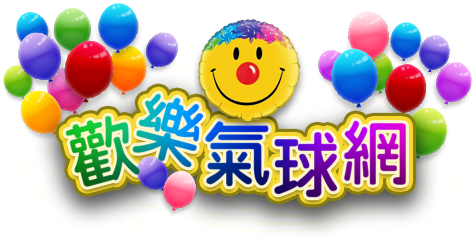造型設計線上教學
解釋名詞
1.氣球編號說明:
260q 第一個數字表示吹滿氣後,氣球的直徑為 2吋;第二與第三個數字表示吹滿氣後,氣球的長度為60吋;而後面的字母代表製造廠商-Qualatex。
2.氣球部位說明:
‧尾部-未充氣的部分
‧球體-充氣的部分
‧結點-打結的部分
‧頭部-靠近結點的充氣部分
‧嘴部-打結後留下的部分

3.結點與球體編號說明:
‧球體-由頭部算起,依序為1,2,3,4
‧結點-嘴部的結點編號為1,依序為1,2,3,4

氣球綁法
1.
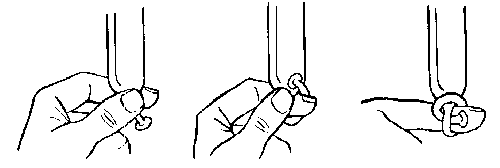
2.
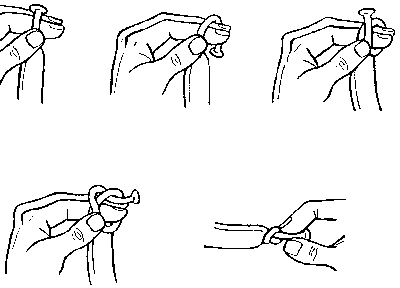
3.

321Q蘋果氣球打法:

321Q蜜蜂做法:

尺寸大小
請先將下面圖檔copy起來(將滑鼠移到下面圖案處,並按滑鼠右鍵選
"Save Image As" 功能儲存),再以300dpi印表機列印,可得原稿尺寸。做造型時即可藉此量度尺寸而做出正確的大小。
另一個偷懶的方法是:
1"→二個手指幅寬
2"→三個手指幅寬
3"→四個手指幅寬
4"→五個手指幅寬
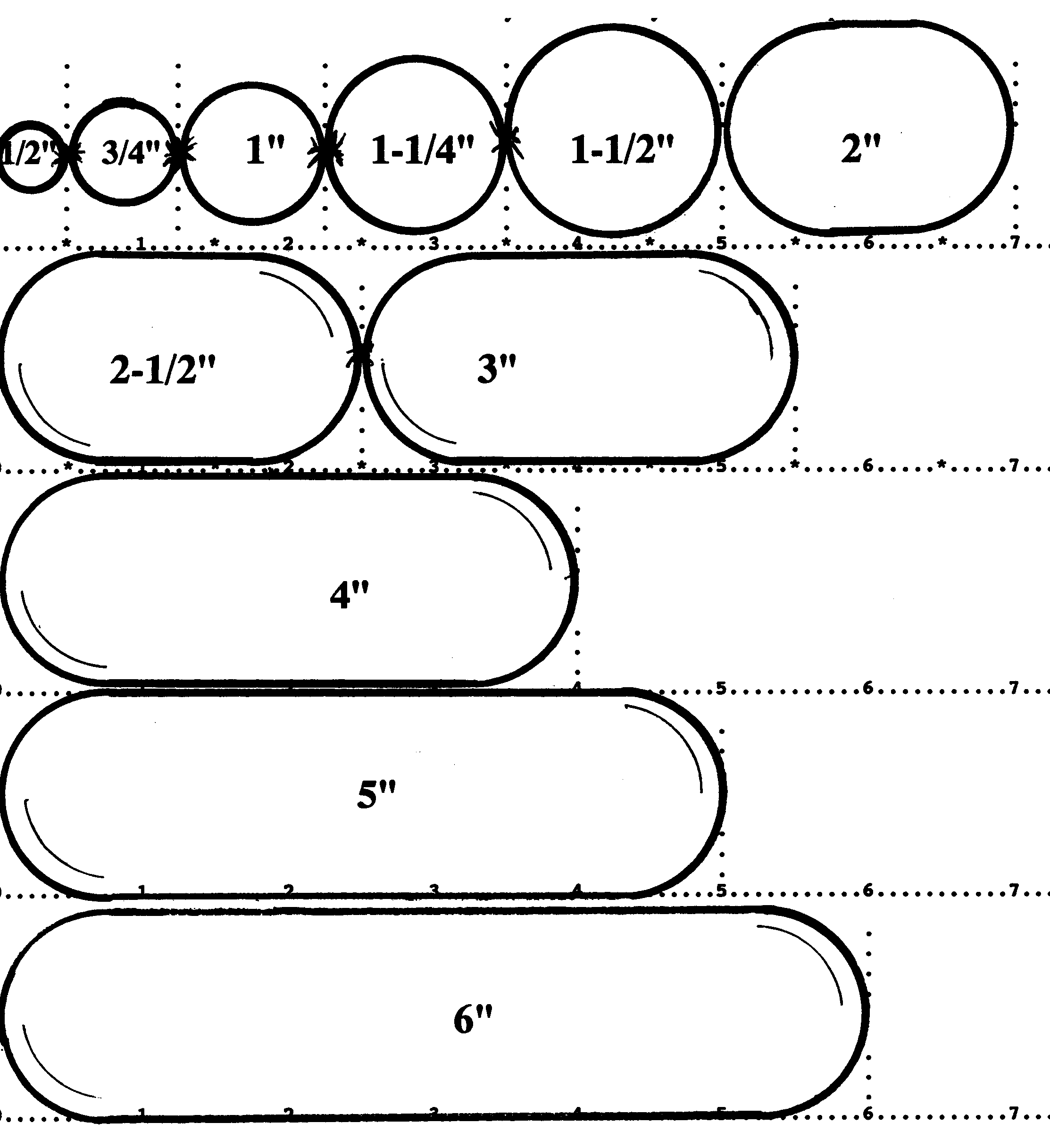
基本折法
Balloon Twists
以下列出常見的氣球基本扭轉方法.經由這些扭轉方法的組合,即能創造千變萬化的各種造型氣球。

Lock Twist
 先轉出相同尺寸的二個泡泡,再將此二泡泡扭轉在一起。這是最常見的轉法,普遍使用在腿和耳朵等處。例如簡單的狗狗造型等。
先轉出相同尺寸的二個泡泡,再將此二泡泡扭轉在一起。這是最常見的轉法,普遍使用在腿和耳朵等處。例如簡單的狗狗造型等。
Pinch Twist (Ear Twist)
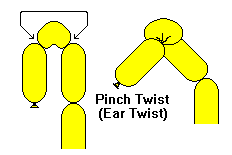 轉一個1~1.5吋的泡泡,右手抓住旁邊的二個氣泡,然後用力將相鄰的兩個結點捏(Pinch)在一起(可用左手食指勾出氣泡),然後以左手旋轉中間泡泡二圈(用力轉不要怕弄破),即能轉出一個耳朵來。此種轉法可稱為「熊耳朵」,常使用在耳朵、嘴唇、關節,或者有時候當作固定結來連結其他泡泡。
轉一個1~1.5吋的泡泡,右手抓住旁邊的二個氣泡,然後用力將相鄰的兩個結點捏(Pinch)在一起(可用左手食指勾出氣泡),然後以左手旋轉中間泡泡二圈(用力轉不要怕弄破),即能轉出一個耳朵來。此種轉法可稱為「熊耳朵」,常使用在耳朵、嘴唇、關節,或者有時候當作固定結來連結其他泡泡。
Toe Twist
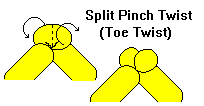 首先做一個熊耳朵,再以兩手抓這泡泡的兩端,把它扭轉成兩部分,每顆小球大約
1/2"。此種轉法使用在腳、手、眼睛。
首先做一個熊耳朵,再以兩手抓這泡泡的兩端,把它扭轉成兩部分,每顆小球大約
1/2"。此種轉法使用在腳、手、眼睛。
Pinch-pop Series
 此種轉法是為了將氣球分成獨立的兩部分,使分開的部分不必打結而能有漂亮的尾部。首先轉出三個等大的小泡泡,為了方便施工可在其下方先打一個
Lock Twist
固定(不打亦可)。接著如圖將對稱的左右二球各轉出一個熊耳朵來(轉5圈)。
此種轉法是為了將氣球分成獨立的兩部分,使分開的部分不必打結而能有漂亮的尾部。首先轉出三個等大的小泡泡,為了方便施工可在其下方先打一個
Lock Twist
固定(不打亦可)。接著如圖將對稱的左右二球各轉出一個熊耳朵來(轉5圈)。
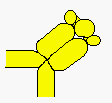 接著也可以將二個熊耳朵再做成 Toe Twist。
接著也可以將二個熊耳朵再做成 Toe Twist。
 最後弄破中間的泡泡,即可形成兩個獨立氣球。(如果只做
Ear Twist 則成為兩個獨立的熊耳朵,可當成手掌設計;若做成 Toe Twist
則可當成兩個獨立的腳掌設計)
最後弄破中間的泡泡,即可形成兩個獨立氣球。(如果只做
Ear Twist 則成為兩個獨立的熊耳朵,可當成手掌設計;若做成 Toe Twist
則可當成兩個獨立的腳掌設計)
Loop Twist
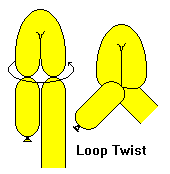 此種轉法就是以一個較長的泡泡來做耳朵轉法,又稱為象耳朵。使用在大耳朵、手、貴賓狗的頭等。
此種轉法就是以一個較長的泡泡來做耳朵轉法,又稱為象耳朵。使用在大耳朵、手、貴賓狗的頭等。
Apple Twist (Tulip Twist)
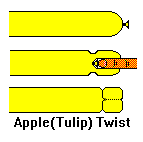 這是使用260q做出蘋果外形的轉法。首先以右手食指將打結處推進約
2"
,以左手由球外將打結處抓緊而拉出右手,然後以右手將其旋轉 5
圈後放開即成一蘋果旋轉 (指甲要修剪,否則會刺破氣球)。此種轉法可做手、腳或漂亮的蘋果花束。
這是使用260q做出蘋果外形的轉法。首先以右手食指將打結處推進約
2"
,以左手由球外將打結處抓緊而拉出右手,然後以右手將其旋轉 5
圈後放開即成一蘋果旋轉 (指甲要修剪,否則會刺破氣球)。此種轉法可做手、腳或漂亮的蘋果花束。
Bird Body (3-Bubble Roll-Through)
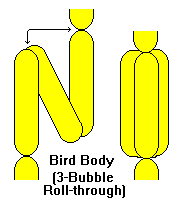 先轉出三個相同長度的泡泡,以
Lock Twist
扭轉二鄰接的泡泡後,將第三個泡泡小心地推進二泡泡之間。一邊滾動(翻出)外部的二泡泡,一邊壓進第三個泡泡,如此較易操作。此種轉法使用在鸚鵡的肚子、頑皮豹的嘴。
先轉出三個相同長度的泡泡,以
Lock Twist
扭轉二鄰接的泡泡後,將第三個泡泡小心地推進二泡泡之間。一邊滾動(翻出)外部的二泡泡,一邊壓進第三個泡泡,如此較易操作。此種轉法使用在鸚鵡的肚子、頑皮豹的嘴。
註:只要再接上一個等長的泡泡,即成四泡泡。四泡泡可使用在肚子、眼睛等。
Hook Twist
 鉤子扭轉法類似蘋果扭轉,只不過要推進長一點的距離(盡量深入
),而且食指是沿著底部深入,左手抓的部位也是在底部。另外食指要彎曲拉出。這是難度較高的高級技巧,使用它將使您的造型與眾不同。
鉤子扭轉法類似蘋果扭轉,只不過要推進長一點的距離(盡量深入
),而且食指是沿著底部深入,左手抓的部位也是在底部。另外食指要彎曲拉出。這是難度較高的高級技巧,使用它將使您的造型與眾不同。
S-Hook Twist
 S
型鉤子扭轉法與鉤子扭轉法類似,只是彎曲壓入260q內部(手指盡可能再深入即可達成),此法可用來表現動物的尾巴。
S
型鉤子扭轉法與鉤子扭轉法類似,只是彎曲壓入260q內部(手指盡可能再深入即可達成),此法可用來表現動物的尾巴。
折法動畫
Apple Twist

Bird Body

Pinch Twist (Ear Twist)

Toe Twist (Split Twist)

Loop Twist (Elphone Twist)

Insideball Twist

Pop Twist

造型教學
Dog
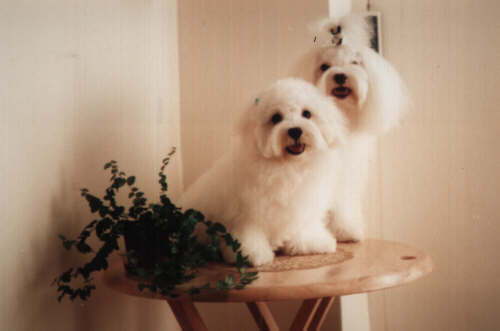
Whoop!貼錯相片了,這是我們家的Doudou與Yuyu :-)
Pumpkin
南瓜是典型「秋收冬藏」的蔬菜,以我在北投市民農場的實作經驗,南瓜確實是一種很好的蔬菜。一方面其生命力很強(颱風一來其他瓜類死光光,唯獨南瓜依舊活著),二來其生長期很長(須比其他瓜類多種三個月才能收成),三來營養成分很高。我通常將其切丁後煮甜湯,冰過後品嚐風味一流。網主在此極力推薦給各位網友!(變成上烹調課了 :-) 南瓜造型的做法是取一條橘色 260q打滿氣後
,捏住前端距嘴部 6"位置,將頭部的氣放掉(這是頭部洩氣的標準做法)。接著再漏一點氣直到出現
1"尾部為止。把頭尾綁在一起形成一個圓圈(盡量綁在尾部尖端部位,留下未充氣部分於球體上,形成柔軟的球體)。然後把球體壓成平行的兩段如上圖,接著旋轉其中一段形成兩個結點平分球體為相等的兩部分(若不相等,應轉開結點,擠壓較長一方的球體使其等長)。
南瓜造型的做法是取一條橘色 260q打滿氣後
,捏住前端距嘴部 6"位置,將頭部的氣放掉(這是頭部洩氣的標準做法)。接著再漏一點氣直到出現
1"尾部為止。把頭尾綁在一起形成一個圓圈(盡量綁在尾部尖端部位,留下未充氣部分於球體上,形成柔軟的球體)。然後把球體壓成平行的兩段如上圖,接著旋轉其中一段形成兩個結點平分球體為相等的兩部分(若不相等,應轉開結點,擠壓較長一方的球體使其等長)。
 平分氣球為三段,成為六個等大的泡泡。(這六個泡泡要等大且很柔軟,這是南瓜能否對稱均勻的必要條件
平分氣球為三段,成為六個等大的泡泡。(這六個泡泡要等大且很柔軟,這是南瓜能否對稱均勻的必要條件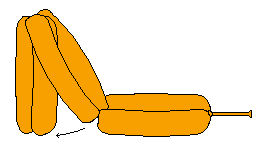 接下來需要一點技巧與勇氣,如圖將左邊二泡泡塞入中間二泡泡之中,形成一個四泡泡的 Bird
Body。並調整個泡泡使其均勻對稱(技巧是塞入的泡泡要往嘴部方向拉,使結點緊密的接觸)
接下來需要一點技巧與勇氣,如圖將左邊二泡泡塞入中間二泡泡之中,形成一個四泡泡的 Bird
Body。並調整個泡泡使其均勻對稱(技巧是塞入的泡泡要往嘴部方向拉,使結點緊密的接觸)
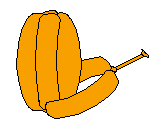 如圖,再將最後一環套上。並調整個泡泡使其均勻對稱(結點要緊密的接觸,必須拉出裡面的泡泡)。
如圖,再將最後一環套上。並調整個泡泡使其均勻對稱(結點要緊密的接觸,必須拉出裡面的泡泡)。
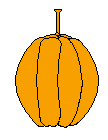 調整所有的結點使其緊密的貼在一起,使泡泡左右對稱。可能第一次做出來不成樣,但多試試就能做出圓滿勻稱的漂亮南瓜了。
調整所有的結點使其緊密的貼在一起,使泡泡左右對稱。可能第一次做出來不成樣,但多試試就能做出圓滿勻稱的漂亮南瓜了。
造型變化:
1.可使用兩條 360P做出大大的南瓜,當裝飾品很漂亮。
2.若使用 130T做出的小南瓜可當鬱金香的花苞,配合綠色的花徑就是漂亮的氣球花。(花徑的做法:以兩個熊耳朵Pinch Twist撐住花苞,以象耳朵Loop Twist做出葉子)
2.鬱金香的造型相片請按這裡:鬱金香造型
Palm Tree
提到棕櫚樹,自然而然就會想到充滿浪漫風情的夏威夷。躺在夕照下的Maui島海攤上,清澈的海天伴隨著輕柔的晚風,真有著人間仙境的感覺。我尤其喜歡在歐胡島Waikiki海灘上吹著長笛(曾有一老外要求我吹奏The shadow of your smile,這是我最喜歡的曲子,當時真有巧遇知音的感動)。OK,在進入造型教學之前,我們先引起動機,先來分享夏威夷令人難忘的經歷:
★日本神社前堆積的石塊聽說是祈福用的,堆的越高願望就越容易達成(於是就看到比誰堆的高)。 這一幕在夏威夷大島火山口邊亦再度出現,我想風土民情東西方應該是英雄所見略同,便趨前仔細觀看。不同的是,這些用黑曜岩堆積的石堆旁還有幾隻單腳鞋子呢(還是MIT)!據導遊(醬油)如是說:Hawaii的原住民認為火山爆發是「希拉」在生氣,他們把噴出的黑曜岩當作是不祥之物(我本不知而帶了一小塊上車,結果被司機制止)。因此當地居民有一習俗,當其有不順遂之事時,會在火山熔岩(黑曜岩)旁將該事輕聲說出,並一邊講一邊堆石頭,他們認為如此這般則霉運就被壓在希拉的詛咒下了(心理學上的轉移在東西方竟有截然不同的表現,一是積極的祈福,一是消極的詛咒。不過壓在石頭下這點,東西方倒是相同:白蛇被壓在雷峰塔下與偷火下凡的???被宙斯壓在大石下)。那麼怎麼會有單腳的鞋子呢?原來是好奇的觀光客踢倒這些石堆後,壓住的惡魔被解放後將對踢石的人不利,當初被壓住之厄運亦將轉移至該觀光客身上。(有點像神燈巨人:巨人不思感恩竟欲加害於釋放者,還好神燈主人夠聰明,直說我不相信這麼小的燈怎麼可能裝的下你這巨人,於是...)。那麼惹禍了,怎麼辦呢?只要趕快將「踢館」的那一隻鞋子取下,放在石頭邊,重新一邊堆石一邊講這一段話:「踢你的不是我,是這一隻鞋子,你找它算帳」。然後趕快溜!(我倒好奇為什麼那麼多MIT的鞋子,我想要不是台灣製鞋工業發達,使得舉世皆為MIT牌,那就一定是台灣觀光客比較皮,想回憶踢鐵罐的童年!)
★另外在恐龍灣潛水時(所謂『潛水』應該說成『淺水』,乃因在淺水處以蛙鏡觀看,欲換氣時只需站立即可露出水面),有幾千條魚穿梭身旁索食十分壯觀(啄的讓你全身發癢)。其中有一幕倒令我十分好奇︰有一些魚竟然臀部整塊肉不見了!據導遊說:「日本人以前喜歡在恐龍灣釣這種魚,並當場殺西米。後來恐龍灣宣布為禁釣之浮潛專區後,日本人就改帶刀子下海,抓到這種魚當場把肉質細緻之屁股肉割下生吃,這樣就不違反禁釣規定,於是就出現這種步履蹣跚的殘障魚了!」
 扯遠了,接下來上課了。本造型須三條
綠色 260q與兩條 棕色或橘色 260q。首先將一條綠色 260q打滿氣,然後洩一點氣後,首尾相接打成一個大環。接著與南瓜類似,轉出二個平行而等大的泡泡。然後將二個結點結合在一起形成一個大8字(可做兔子的大耳朵),再把二個圈圈各轉出平分等大的泡泡。如此就將一個大圈轉成四個等大的泡泡來。同樣的方法,共做出三條來。
扯遠了,接下來上課了。本造型須三條
綠色 260q與兩條 棕色或橘色 260q。首先將一條綠色 260q打滿氣,然後洩一點氣後,首尾相接打成一個大環。接著與南瓜類似,轉出二個平行而等大的泡泡。然後將二個結點結合在一起形成一個大8字(可做兔子的大耳朵),再把二個圈圈各轉出平分等大的泡泡。如此就將一個大圈轉成四個等大的泡泡來。同樣的方法,共做出三條來。
接著把這三條綠色260q之中央結點結合在一起,調整其位置如圖。使其構成六條放射狀展開之平面(若不在平面上,要將其拉回至應在的位置)。
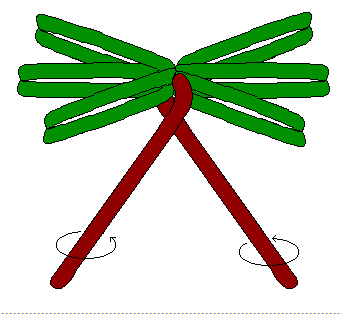
然後將二條棕色 260q充滿並稍微漏氣後,將二者的嘴部綁在一起,繞過星狀葉子的中央結點。接著要捻出一條麻花來,捻法是:拉著二條氣球旋轉相同的方向,就能將二者捻在一起。
 當捻到長度剩下 12"
時,將二者轉在一起而形成一個結點。然後每一條都做一個周長
8"的象耳朵Loop Twist來,各自留下 4"的尾部。最後將這些象耳朵與尾部整理在同一平面,形成棕櫚樹的底座,並調整其重心使棕櫚樹能站立在地上。至此,一棵漂亮的棕櫚樹終於大功告成!
當捻到長度剩下 12"
時,將二者轉在一起而形成一個結點。然後每一條都做一個周長
8"的象耳朵Loop Twist來,各自留下 4"的尾部。最後將這些象耳朵與尾部整理在同一平面,形成棕櫚樹的底座,並調整其重心使棕櫚樹能站立在地上。至此,一棵漂亮的棕櫚樹終於大功告成!
注意事項:
1.如果站不起來,可做一較大的 Stand。
2.如果樹幹容易彎腰鞠躬,表示氣球太柔軟,作樹幹時就不要洩太多氣。
3.如果葉子或 Stand無法穩定在同一平面上,此時可藉助於氣球專用膠的粘著。
造型變化:
若能在樹葉與樹幹之接合處,以圓形
5"球做出椰子來,造形就更漂亮了。
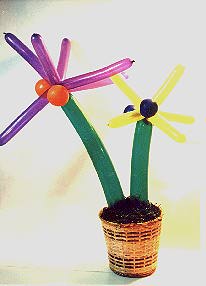
May Flowers
我們先民「唐山過海」跨過黑水溝來台開闢。一如1620年102位清教徒 Pilgrim Fathers,搭乘「五月花」號至新大陸開墾殖民地一般。因著他們當年胼手胝足闢路襤褸,才有現在的我們。因此「五月花」對於美國人而言,其重要性自不在話下。
提到帆船,除了想到「金銀島」的情節之外,我還想到墾丁的船帆石(又稱尼克森人頭)。那裡是我認為全台潛水最棒的地方,七彩的珊瑚與種類繁多的生物,令人目不暇給。提到墾丁,我又有故事要說(又來了):
因為我喜歡石洞探險,有一次溜進墾丁森林遊樂區第三區(未開放),意外發現了數個未標號的鐘乳石洞。其中一個石洞裡的鐘乳石還是活的(尚有水流,還在長晶),在手電筒燈光下閃閃發光,當時驚喜於台灣尚有如此精雕細琢的槐寶,同時也懷疑墾丁國家公園是否已知此地。然後,我就把這件事當作祕密隱藏了好久。直到有一天看到時報週刊,說墾丁發現台灣最大的鐘乳石洞。赫然發現封面刊出的相片就是當初我探訪的那個地洞,心中立即升起一種不祥的感覺。該文章說,該洞被發現是因為獵人追捕山羊時(我也曾與山羊正面遭遇,其攀岩的技巧真是神乎其技),當時獵人看到羊躲進一狹隙後不見蹤影。便以煙薰逼其離開地洞,當久久未見其出來時,獵人就進入側身亦難通過之狹縫,赫然發覺內部竟十分開闊,於是乎就稱發現了台灣最大的鐘乳石洞(按:由於該洞口很窄,使得巡山員巡了幾十年亦未發現該洞口。就因如此,這封閉的空間才得以長出台灣最漂亮的鐘乳石)。於是,我就戴著不安的心趕往該處。一進洞內一看,眼淚都差點掉下來,我看到了盜採鐘乳石者留在洞頂上方之木棍及滿地敲碎的鐘乳石,心中悲悽久久不能平息。直到現在,我仍無法忘懷這一幕景象...
本帆船造型需黃色260q兩條做船身,一條棕色做桅竿,一條淺藍色當帆布。
 首先分別將兩條黃色260q打滿氣後,釋放氣體至留有
1吋之尾部(捏尾部氣體來洩氣)後打結。將第一條距尾部 6吋處與第二條之嘴部打結。接著將第二條(較長那一條)轉出
12吋、 3吋、3吋球來,將二個 3吋中間之第三結點處與第一條的
12吋泡位置結合。然後將這二個 3吋球再轉在一起。
首先分別將兩條黃色260q打滿氣後,釋放氣體至留有
1吋之尾部(捏尾部氣體來洩氣)後打結。將第一條距尾部 6吋處與第二條之嘴部打結。接著將第二條(較長那一條)轉出
12吋、 3吋、3吋球來,將二個 3吋中間之第三結點處與第一條的
12吋泡位置結合。然後將這二個 3吋球再轉在一起。
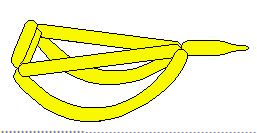
最後將二球之末端均綁在第一球的右端結點上,這樣就做好了船身。
 接著吹出一條棕色的260q,也是一樣留
1吋之尾部後打結。由頭部開始,分別轉出1吋、6吋、3吋、6吋、1吋之泡泡,這其中的1吋泡是當作連結泡固定用。將第三、第四結點綁在船身甲板中央處。然後將6吋、3吋、6吋的泡泡圍轉在一起(第二與第五結點)。
接著吹出一條棕色的260q,也是一樣留
1吋之尾部後打結。由頭部開始,分別轉出1吋、6吋、3吋、6吋、1吋之泡泡,這其中的1吋泡是當作連結泡固定用。將第三、第四結點綁在船身甲板中央處。然後將6吋、3吋、6吋的泡泡圍轉在一起(第二與第五結點)。
![]()
接著淺藍色的260q也是吹滿後洩氣,留 1吋之尾部後打結。由頭部開始,分別轉出1吋、3吋、6吋、6吋、6吋、3吋之泡泡。
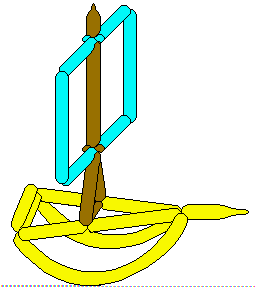 將淺藍色的1吋泡當固定泡綁在距棕色氣球第六結點上方
6吋處。接著如右圖將其繞成一個正方形,留下淺藍色氣球最後的小尾部泡,亦當成固定泡。調整上方兩個一吋固定泡,使其落於桅竿的兩側(這樣才有固定功能)。下方棕色的兩個一吋固定泡也是如此處理。最後調整帆布的角度,使其與桅竿的三角型處在同一平面上。並將兩條弧形的黃色氣球彼此向內扳,這樣一條隨風浪搖盪而飄洋過海的帆船就大功告成了!
將淺藍色的1吋泡當固定泡綁在距棕色氣球第六結點上方
6吋處。接著如右圖將其繞成一個正方形,留下淺藍色氣球最後的小尾部泡,亦當成固定泡。調整上方兩個一吋固定泡,使其落於桅竿的兩側(這樣才有固定功能)。下方棕色的兩個一吋固定泡也是如此處理。最後調整帆布的角度,使其與桅竿的三角型處在同一平面上。並將兩條弧形的黃色氣球彼此向內扳,這樣一條隨風浪搖盪而飄洋過海的帆船就大功告成了!
應用:船身不變而上方發揮您的巧思,就可以把它變成搖搖木馬、不倒翁等造型了。
Wildcat
使用黃色260Q,這種顏色比較像是貓科動物,若是使用橘色就比較像是老虎的顏色,而使用粉紅色就是頑皮豹了。
首先將一條 260Q吹氣後留 5" 尾部不充氣.

![]() 依序轉出 1"、1.5"、1"、1/2"
等(1、2、3、4)四個泡泡來,然後如圖將2、3、4的泡泡環環結成三角形.(中間編號3的1"泡等一下要做出熊耳結
Pinch Twist)
依序轉出 1"、1.5"、1"、1/2"
等(1、2、3、4)四個泡泡來,然後如圖將2、3、4的泡泡環環結成三角形.(中間編號3的1"泡等一下要做出熊耳結
Pinch Twist)

再轉出 1.5"、1"、1/2"(編號5、6、7)等三個泡泡,再將此三泡環結在一起。(中間編號6的1"泡等一下也要做出熊耳結)
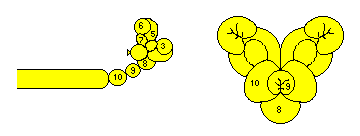
接著轉出 1"、1/2"、1"(編號8、9、10)等三個泡泡,並將編號9的
1/2泡做出熊耳結,然後將編號1的嘴部拉近此熊耳結並固定。調整編號8、10、1等三個1"泡,使兩個1"泡在上形成兩腮而一個1"泡在下形成下巴。
然後將編號3、6的1"泡各做出熊耳結來,並調整編4、7的
1/2" 泡,使其轉向正面形成眼球。

最後轉出一個 1/2" 泡當脖子,兩個 3"
泡當前腿,一個 4" 泡當肚子,兩個 3"
泡當後腿腿,並將最後尾部的長泡泡扭曲一下,如此一隻野貓就大功告成了。當然您也可以畫一下眼睛還有貓身上及尾巴的花紋(有道是畫虎不成反類犬,而畫貓不成不知像?^.^
Frog
提到青蛙就想起小時候在水田釣青蛙的快樂時光,還有黏蟬、灌 ㄉㄛˇ ㄍㄠˇ、抓螢火蟲、淡水河摸蛤(摸 ㄌㄚˇ ㄚ兼洗褲)等等,曾幾何時這些情景早已不復見!唉!我們真是等到失去了才會懂得珍惜的!
將一條 綠色的260Q 充氣 1/3 (或是留尾7")後打結;
![]() 首先打出一個 1.5''
的軟泡以方便待會伸展之用,接著打出 2''、1.5''、1.5''、2''等四個泡泡,並將此四個泡泡環在一起
首先打出一個 1.5''
的軟泡以方便待會伸展之用,接著打出 2''、1.5''、1.5''、2''等四個泡泡,並將此四個泡泡環在一起
 如圖拉起嘴部將1號軟球繞過3、4泡中間並轉一圈回到原處後固定,如此將形成青蛙的頭部。
如圖拉起嘴部將1號軟球繞過3、4泡中間並轉一圈回到原處後固定,如此將形成青蛙的頭部。
 接著轉出二個 2'' 泡當前腿,一個 2''
泡當肚子。
接著轉出二個 2'' 泡當前腿,一個 2''
泡當肚子。
 預留尾部 1''
泡當固定用(咦?青蛙有尾巴嗎?)
預留尾部 1''
泡當固定用(咦?青蛙有尾巴嗎?)
將中間泡泡等分為兩部分,分別做出象耳朵來Loop Twist。並將尾部轉出一個熊耳結而把多餘的氣球繞進腿間。
 最後點出眼睛與鼻子嘴巴就大功告成了。(不會畫青蛙的話,不妨去抓一隻來觀察。不過現在好像蛙叫就已經很難聽到了,更何況是抓來呢!)
最後點出眼睛與鼻子嘴巴就大功告成了。(不會畫青蛙的話,不妨去抓一隻來觀察。不過現在好像蛙叫就已經很難聽到了,更何況是抓來呢!)
Multiple Choice
這會稱為 Multiple Choice 是因為此種造型的頭部可以做出泰迪熊、無尾熊、豬寶寶.... ,只要發揮您的想像力,它還可以變出許多有趣的造型來。首先將一條 260Q 充滿 3/4 (或留3"尾)後打結。
 首先做出一個蘋果結 Apple Twist.
首先做出一個蘋果結 Apple Twist.
 接著依序打出 2"、3"、1.5"、3"、1.5"、3"等六個泡泡來,並將後五個泡泡(3"、1.5"、3"、1.5"、3")環成一圈如下圖。
接著依序打出 2"、3"、1.5"、3"、1.5"、3"等六個泡泡來,並將後五個泡泡(3"、1.5"、3"、1.5"、3")環成一圈如下圖。
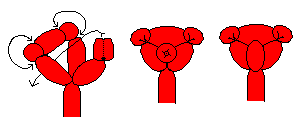 如左圖,將蘋果結塞入此環圈中,並將兩個1.5"泡做出熊耳結來 Pinch Twist
。接著您可以有兩種選擇:第一種是將蘋果結當正面,這樣就是泰迪熊或是豬寶寶的臉。第二種是將蘋果結當背面,這樣
2" 泡就變成無尾熊的鼻子了。
如左圖,將蘋果結塞入此環圈中,並將兩個1.5"泡做出熊耳結來 Pinch Twist
。接著您可以有兩種選擇:第一種是將蘋果結當正面,這樣就是泰迪熊或是豬寶寶的臉。第二種是將蘋果結當背面,這樣
2" 泡就變成無尾熊的鼻子了。
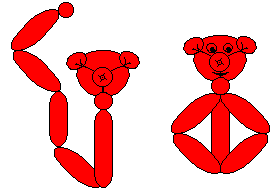 接著轉出一個1.5"泡當脖子,一個5"泡當肚子。並在氣球尾部預先留下一個1"泡當尾巴,然後將尾巴與肚子之間的氣球等分為四份,如圖做出雙手與雙腳來,最後並將尾巴放在適當的位置(若放錯位置,哦哦!那就變成限制級了!^_^)。您也可以幫這隻熊寶寶化妝一下,
最後不管坐著(手長腳短才能坐)或是將其套進小朋友的小小手腕中,這隻熊寶寶必將成為小朋友們的歡樂來源!
接著轉出一個1.5"泡當脖子,一個5"泡當肚子。並在氣球尾部預先留下一個1"泡當尾巴,然後將尾巴與肚子之間的氣球等分為四份,如圖做出雙手與雙腳來,最後並將尾巴放在適當的位置(若放錯位置,哦哦!那就變成限制級了!^_^)。您也可以幫這隻熊寶寶化妝一下,
最後不管坐著(手長腳短才能坐)或是將其套進小朋友的小小手腕中,這隻熊寶寶必將成為小朋友們的歡樂來源!
Penguin
 找來白色和黑色的260Q(為了清楚起見,圖中以藍色代替黑色),分別將其充滿一半長度(約留6"尾)後打結,並將兩球的嘴部彼此綁在一起。先將白球轉出兩個
1.5" 泡,將此二泡扭成一個雙泡結(Lock Twist)。接著將黑球轉出
0.5" 與 1.5" 的二個泡泡來。
找來白色和黑色的260Q(為了清楚起見,圖中以藍色代替黑色),分別將其充滿一半長度(約留6"尾)後打結,並將兩球的嘴部彼此綁在一起。先將白球轉出兩個
1.5" 泡,將此二泡扭成一個雙泡結(Lock Twist)。接著將黑球轉出
0.5" 與 1.5" 的二個泡泡來。
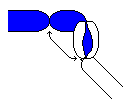 然後拉這個黑色 0.5 "
泡跨過白色球,將這顆黑色 0.5 "
泡拉成淚滴狀以形成鳥嘴,並將黑色的 1.5"
泡連結至白球上而形成四泡(二黑二白)。
然後拉這個黑色 0.5 "
泡跨過白色球,將這顆黑色 0.5 "
泡拉成淚滴狀以形成鳥嘴,並將黑色的 1.5"
泡連結至白球上而形成四泡(二黑二白)。
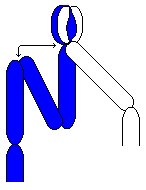 接著將黑色球轉出三個 5"泡並扭成鸚鵡肚 Bird Body.
接著將黑色球轉出三個 5"泡並扭成鸚鵡肚 Bird Body.
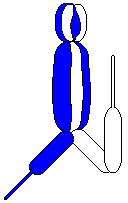 並將白色球轉出一個 5"泡,結合在鸚鵡肚上形成四泡泡。接著轉出
4"泡做出一個環泡結Loop Twist ,共做出二個以形成其雙腳。剩下的白色球打結並固定後將多餘部分剪去。
並將白色球轉出一個 5"泡,結合在鸚鵡肚上形成四泡泡。接著轉出
4"泡做出一個環泡結Loop Twist ,共做出二個以形成其雙腳。剩下的白色球打結並固定後將多餘部分剪去。
 而黑色球轉出一個 3"泡做出一個環泡結當尾巴,並將多餘部分剪去。最後在鳥嘴兩旁的白色泡泡上畫出眼睛,這樣一隻可愛的企鵝就完成了。
而黑色球轉出一個 3"泡做出一個環泡結當尾巴,並將多餘部分剪去。最後在鳥嘴兩旁的白色泡泡上畫出眼睛,這樣一隻可愛的企鵝就完成了。
Kissing Swans
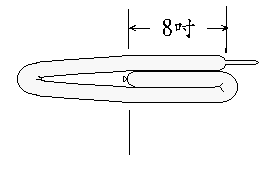
現在我們要做出一對恩愛的天鵝,您可以先使用一條白色的 260Q,吹氣後留 2.5" 尾。如左圖,將打結的嘴部置於距離尾部 8"處打結,並將形成一圈的氣球由中間等分成兩等分。並將嘴部多繞幾圈以固定這些圈圈。
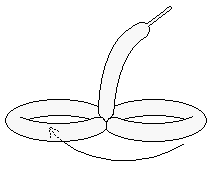
如左圖,接著將其中的一個圈圈小心壓進另一個圈圈中以形成天鵝的肚子。
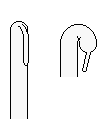
天鵝的頭部則是最難折的部分,先如左圖將未充氣的氣球尾部緊靠在已充氣的氣球上,然後雙手握住氣球並擠壓,使氣體被擠進未充氣的氣球尾部,這樣就能形成彎曲的球體而類似天鵝彎曲的頭部一般。初學者通常會抱怨擠出來的形狀不像,但只要多加嘗試,您一定可以把握出要領而擠出漂亮的頭部來。
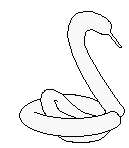
 如此,一隻漂亮的白天鵝就形成了。您可以把它放在浴缸中(或是游泳池),讓您的小寶寶陪它好好游泳。另外,如同本造型的名稱 Kissing Swans,您可以使用一條淺藍色與一條粉紅色的260Q分別做出一對正在親親的天鵝,天鵝嘴部可以使用氣球專用接合膠來接合以形成一個漂亮的愛心。您只要將它們送給您的阿娜達,相信必能使您們更加的恩愛。最後謹以此對天鵝
如此,一隻漂亮的白天鵝就形成了。您可以把它放在浴缸中(或是游泳池),讓您的小寶寶陪它好好游泳。另外,如同本造型的名稱 Kissing Swans,您可以使用一條淺藍色與一條粉紅色的260Q分別做出一對正在親親的天鵝,天鵝嘴部可以使用氣球專用接合膠來接合以形成一個漂亮的愛心。您只要將它們送給您的阿娜達,相信必能使您們更加的恩愛。最後謹以此對天鵝
祝天下有情人終成眷屬,更祝天下眷屬終是有情人!
Kissing Poodles

這一對玩親親的貴賓狗造型是進階的代表作品,因為能轉出30顆一樣大的1"球可不是一件容易的事!首先將一條 260Q 吹氣 9" 後打結。為什麼需要留這麼長的尾部呢?因為要轉出的球數越多就需要留越長的尾部來,否則轉到後來氣體沒有後退空間時,硬轉就會撐破氣球了。先轉出5顆 1" 球(尺寸要符合規定),並將 2、5以 Loop Twist 結合在一起(#1是尾巴,3、4是後腳掌, 2、5是後腿)。
![]()
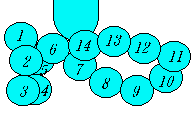
然後轉出 9 個 1"泡泡(#6~#14),並將#7~#14泡環成一圈(#6是肚子,#7~#14則是要做出二隻狗的前腳)。
![]()

接著轉出#15當脖子,#16~#18三顆球結合成三角形當臉部,#19當鼻子。
![]()
![]()
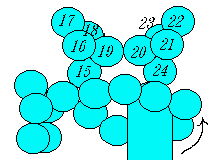
再來就是要轉出另一隻貴賓狗了。轉出#20當鼻子,#21~#23當臉部,#24當脖子。並將剩餘的球體塞入之前做的#7~#14之8顆球泡之中,塞入後並依箭頭方向將球體向右拉。
![]()
![]()

現在我們從底部來仰視這8顆球,將(剩餘的球體和#24之間的)結點拉向右側後,將#9~#12四顆球同時一起旋轉,這樣就能形成兩隻貴賓狗的前腳來。
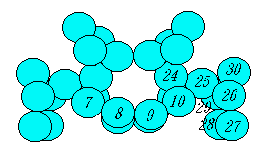 最後將剩餘球體平均的轉出 #25~#30 的6個泡泡來,並將#26~#29
轉出四泡的Loop Twist來,而#30則當成尾巴,這個造型需要多練習幾次才能嘗試出正確的氣泡大小來。最後給您一個建議,您練習時不妨使用深紫色的260Q來做,因為一但失敗就可以把這些泡泡改做成一串葡萄喔!
^_^
最後將剩餘球體平均的轉出 #25~#30 的6個泡泡來,並將#26~#29
轉出四泡的Loop Twist來,而#30則當成尾巴,這個造型需要多練習幾次才能嘗試出正確的氣泡大小來。最後給您一個建議,您練習時不妨使用深紫色的260Q來做,因為一但失敗就可以把這些泡泡改做成一串葡萄喔!
^_^
Motorcycle
This is the one use for the Pinch-pop that can be used to enhance a sculpture.

Inflate the balloon to about 18-20 inches. Twist a 1.5 inch bubble followed by a 5-6 inch bubble. Make a Loop Twist in the larger bubble and tuck the smaller one inside the loop. This makes the rear tire (with a valve stem!).
![]()

Make a 2-3 inch loop twist for the luggage rack/seat back and a 3-inch bubble for the body.
![]()
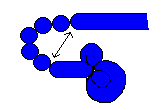
Next make a 5-bubble loop of 1-5 inch bubbles for the handlebars.
Make a Pinch-pop from the three middle bubbles to separate the handlebars.
![]()

Next, comes a small Pinch Twist for the headlight and a larger pinch twist for the gas tank.
![]()

The rest of the balloon will be the front fork and tire. The front fork is a single bubble, made to a length that will leave about 6-7 inches for the front tire.
The front tire will be a loop twist with a 1.5-inch bubble tucked into the loop, similar to the rear tire.
Dragon
You will need two balloons of the same color - usually green or red, leaving about 6
inches uninflated.

 Begin with a Hook Twist and then take the hooked part and twist it into a small soft bubble. Twist this small
bubble into two equal bubbles. You now have the dragon's snout and nostrils. Follow this
with a 1" Pinch Twist and give it a Toe Twist to make eyes. Another 1" pinch twist makes the forehead and sets the angle for the
neck.
Begin with a Hook Twist and then take the hooked part and twist it into a small soft bubble. Twist this small
bubble into two equal bubbles. You now have the dragon's snout and nostrils. Follow this
with a 1" Pinch Twist and give it a Toe Twist to make eyes. Another 1" pinch twist makes the forehead and sets the angle for the
neck.
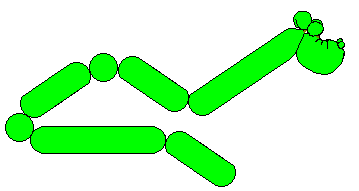 The rest of the balloon will become the neck, one
wing and one front leg. The neck is about a 6" bubble. For the wing twist a 4",
1.5", 4", 1.5", 7", fastening the last twist back to the base of the
neck. You should have a 3-4" leg left over. Pinch twist the 1.5" bubbles on the
wing.
The rest of the balloon will become the neck, one
wing and one front leg. The neck is about a 6" bubble. For the wing twist a 4",
1.5", 4", 1.5", 7", fastening the last twist back to the base of the
neck. You should have a 3-4" leg left over. Pinch twist the 1.5" bubbles on the
wing.
 With the second balloon. Make a foreleg and wing to
match what you already have and twist connect it at the base of the neck. Twist a 4"
body, followed by 3-4" rear legs Lock Twist together,
leaving a long tail.
With the second balloon. Make a foreleg and wing to
match what you already have and twist connect it at the base of the neck. Twist a 4"
body, followed by 3-4" rear legs Lock Twist together,
leaving a long tail.

For variation, you can follow the neck with the body, rear legs and tail, and then make both wings and front legs from a contrasting color second balloon. Now for the story . . .
Snowman
Mr. Snowman needs a white 260, inflated leaving a 5" tail, A black 260 inflated
only about 6-8 inches, and an uninflated orange 260.
![]()
Begin with the black (Shown as dark blue here for clarity) and make a 2-3 inch Apple Twist, followed by three soft 1.5 inch bubbles. Give each of the 1.5 inchers a Pinch Twist. Arrange these around the base of the tulip twist to form the tophat.
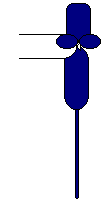 Tie the nozzle of the white balloon to the base
of the hat, then cut off and save the rest of the black.
Tie the nozzle of the white balloon to the base
of the hat, then cut off and save the rest of the black.

 Twist
three 1.5 inch bubbles in the white and make a Bird Body. This will be
the head.
Twist
three 1.5 inch bubbles in the white and make a Bird Body. This will be
the head.
Twist three 3 inch bubbles and make another Bird Body for the center of the body.
.
.
.
.

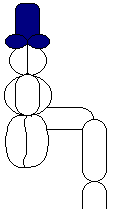 For the
bottom of the body, make two 4-5 inch bubbles and Lock Twist them
together.
For the
bottom of the body, make two 4-5 inch bubbles and Lock Twist them
together.
Repeat this step and push one bubble of one locked pair between the two bubbles of the other pair, giving you four parallel bubbles, attached at both ends.
.
.
.
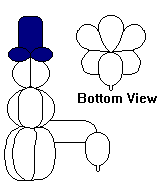 If the remainder of the balloon is shorter
than the bubbles in the four-bubble group, tuck it into the middle of the group to make it
bulge out more. If not, Twist off one more bubble the same size, leaving a short bubble on
the end. Bring this down to make a five-bubble group (see the bottom view at left) and
tuck the short bubble into the middle.
If the remainder of the balloon is shorter
than the bubbles in the four-bubble group, tuck it into the middle of the group to make it
bulge out more. If not, Twist off one more bubble the same size, leaving a short bubble on
the end. Bring this down to make a five-bubble group (see the bottom view at left) and
tuck the short bubble into the middle.
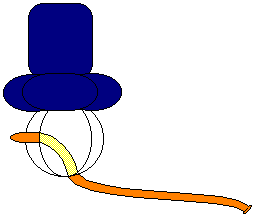 Now let's add the features.
Now let's add the features.
Take the nipple end of the orange 260 and push it between the bubbles that form the head
so that about 3/4 inch sticks out the front. This forms the carrot nose. The rest of the
balloon should come out at the bottom of the head and be wrapped around the neck for a
scarf.
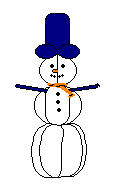 Take the remainder of the black balloon (you
should have about 8 inches) and blow just enough air into it to make it rigid. Don't inflate
it enough to make bubbles, but you may want to have a bulge of about 1/2 inch to maintain
enough pressure to keep it rigid. Tuck this behind one of the bubbles in the middle of the
body to make stick arms. You should have half of it sticking out on each side. Take a
permanent marker to add eyes, mouth and buttons. Arleenie notes that in Arizona the
snowman is a mythical figure and adds: "For an Arizona snowman, I just make the
hat!"
Take the remainder of the black balloon (you
should have about 8 inches) and blow just enough air into it to make it rigid. Don't inflate
it enough to make bubbles, but you may want to have a bulge of about 1/2 inch to maintain
enough pressure to keep it rigid. Tuck this behind one of the bubbles in the middle of the
body to make stick arms. You should have half of it sticking out on each side. Take a
permanent marker to add eyes, mouth and buttons. Arleenie notes that in Arizona the
snowman is a mythical figure and adds: "For an Arizona snowman, I just make the
hat!"
Angel
![]()
Inflate a 260 ballon leaving about a four-inch tail. Twist a 2-inch bubble for the head, then a 3-4 inch arm, three 1-inch bubbles and another arm. Twist the arms together at the neck.
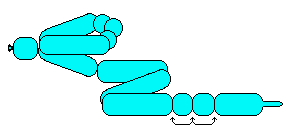
Twist a 4-inch torso, followed by three 4-inch bubbles for the skirt of the robe. Make a Bird Body from the three bubbles, followed by two Pinch Twist for the feet.
¡@
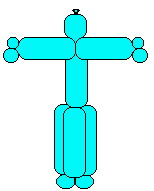
The remainder of the balloon may be popped and tied off or tucked into the skirt to make it fuller. Make a Pinch-pop from the three bubbles on the arms to separate the hands.
¡@
¡@

In a contrasting balloon, make a shallow Apple Twist for a halo. Squeeze the air out of the next part of balloon to make an almost limp 2-inch bubble. Secure the halo to the knot on the top of the head, and bring the limp bubble down the back of the head and twist to the neck. With the remainder of the second balloon make two triangular wings, using bubbles of about 3, 5 and 6 inches. Secure the wings to the neck and the angel is complete.

Optionally, you can cut the limp bubble in the middle and twist the ends into the joints at the top and bottom of the head to seal them off.
June Bug
 The mantis requires four
balloons of the same color. Inflate one balloon leaving about a 3 inch uninflated tail.
Twist a 1 inch bubble, a 2.5 inch and a 5 inch.
The mantis requires four
balloons of the same color. Inflate one balloon leaving about a 3 inch uninflated tail.
Twist a 1 inch bubble, a 2.5 inch and a 5 inch.

Pinch Twist the 2.5 inch and Loop Twist the 5 inch. Tuck the pinch twist inside the loop twist and you have one eye.

Repeat the pinch twist and loop twist to make the other eye and add a 6 inch loop twist for the nose and jaw.
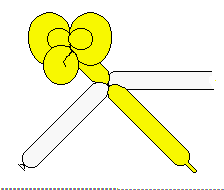
Move the tail end of the balloon and the original 1 inch bubble to the back, forming the back of the head and the neck. Twist about a 3 inch neck, leaving about 12 inches for a front leg. Inflate the remaining 3 balloons leaving about a 2 inch tail. In one of them twist another front leg matching the original.
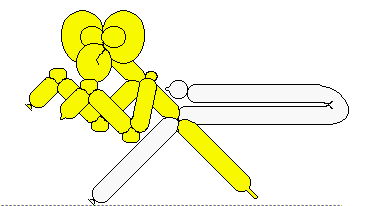
Make two 1-inch pinch twists in each of the legs to form the elbow and wrist joints. Arrange them in the typical 'praying' position characteristic of the mantis. Make a 1-inch pinch twist immetiately behind the front legs to position the thorax. The thorax is just a 6-inch bubble. The remainder of the balloon becomes a center leg. Take the third balloon and make a matching leg as you did for the front legs. Twist a 1-inch bubble in the far end of the third balloon and lock it to the joint where the center legs come together. The long loop twist between forms the abdomen.

Take the fourth balloon and squeeze the air all the way to the end to soften it. Twist the abdomen about 3 inches behind the center legs and attach the center of the fourth balloon at that point. Make 1-inch pinch twist joints in the two sections of the fourth balloon to make the rear legs.
April Showers
 Start with 5 260 balloons and inflate them all
leaving about 3 inches uninflated. It is important to make them as close to the same size
as possible, about 45 inches long.
Start with 5 260 balloons and inflate them all
leaving about 3 inches uninflated. It is important to make them as close to the same size
as possible, about 45 inches long.
Twist a 1 inch bubble in the knot end of each of them and twist all 5 together at this point.
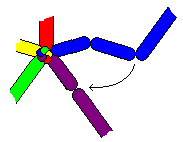
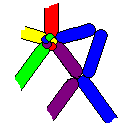
Twist a 4 inch bubble in two of the adjacent arms. In one of them (blue in the drawing) twist a second bubble, 5 inches long.
Lock Twist this second bubble to the first one on the adjacent (purple) arm.
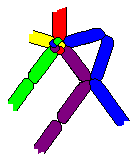
Twist a 5 inch bubble in the second arm and lock twist it to a 4 inch bubble in the third (green) arm. Continue around the structure in the same manner, ending by twisting the fifth arm to the first twist in the first arm.
Once that you have completed the inner ring you are ready to begin the second ring.
![]()
 Again twist a 4 inch bubble in two adjacent
arms. But this time the second bubble needs to be about 10 inches instead of 5. If you
want 5 sections, each a solid color, as in the drawing, you will need to go around the
structure in the opposite direction with each successive ring. If you go the same
direction each time, the colors will spiral around the structure.
Again twist a 4 inch bubble in two adjacent
arms. But this time the second bubble needs to be about 10 inches instead of 5. If you
want 5 sections, each a solid color, as in the drawing, you will need to go around the
structure in the opposite direction with each successive ring. If you go the same
direction each time, the colors will spiral around the structure.
For the third (outer) ring, the long bubbles will need to increase to about 14 inches. It will take some practice to get the proportions just right. When you finish you should have just enough of a small bubble left to hold the last twist in place. Giving this last bubble a Pinch Twist gives it a more finished look.
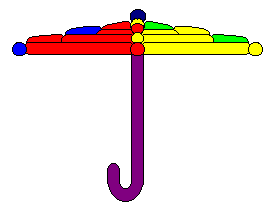 For the handle, inflate a balloon leaving 4
inches uninflated. Fold the uninflated end back and then squeeze the air around the fold
to make the curved end of the handle. From the curved end, measure back about 20 inches
for the handle length. Twist off a 3 inch bubble and give it a pinch twist. Deflate the
rest of the balloon (the knot end) and tie it off. Lock the pinch twist in the handle to
the center of the umbrella.
For the handle, inflate a balloon leaving 4
inches uninflated. Fold the uninflated end back and then squeeze the air around the fold
to make the curved end of the handle. From the curved end, measure back about 20 inches
for the handle length. Twist off a 3 inch bubble and give it a pinch twist. Deflate the
rest of the balloon (the knot end) and tie it off. Lock the pinch twist in the handle to
the center of the umbrella.
Tropical Fish

The design requires four balloons - three of one color and one of a lighter color. Inflate all of them leaving about a 3-inch tail.
In the first dark balloon make two eight-inch bubbles and Loop Twist
them. These will become eye sockets.

In the light balloon make two four-inch bubbles and loop twist them. These will become eyes. Follow with a two-inch bubble.
Make two 12-16 inch bubbles and loop twist them for pectoral fins. Any remaining balloon may be popped and tied off.
¡@
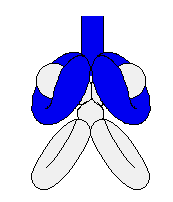
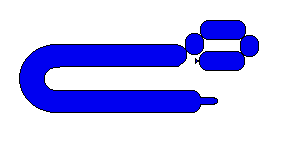
Push each eye into one of the eye sockets, allowing the rest of the dark balloon to extend to the back.
In the second dark balloon twist a 3-inch, 1-inch, 3-inch, 1-inch series. Twist the knot into the last twist to make a loop. Now Pinch Twist the two one-inch bubbles. These will be "cheeks" with the 3-inch bubbles making the lips. Bring the nipple end around and tie it to the opposite side of the lips, making a large loop. Squeeze the loop to distribute the air evenly.
Squeeze the air in the third balloon toward the tail end to distribute it evenly, and then twist in the middle, making two equal bubbles. Place this twist through the large loop in dark balloon 2 behind the lips. Twist the ends of the large loop together, locking balloon 3 in place.
 Slip the pectoral fins through the loop in
balloon 2, arranging so that the knot end of balloon 3 is on the top. You should now have
an ugly mess like the one in the picture at the left.
Slip the pectoral fins through the loop in
balloon 2, arranging so that the knot end of balloon 3 is on the top. You should now have
an ugly mess like the one in the picture at the left.
All the long, loose ends need to be twisted together behind the eye sockets in one big twist in the following manner: 
- The top bubble of balloon 3 should be divided in half. After making the big twist, bring the remaining bubble back over the dorsal (top) side and tie the knot behind the lips.
- The end of balloon 1 should be below the dorsal balloon. Its long end will be used to stabilize the tail and complete the ventral (bottom) side of the fish.
- The large loop will be pulled into the body to hold the pectoral fins in place. The loop remaining behind the big twist will be one part of the caudal (tail) fin.
- The bottom bubble of balloon 3 goes between the pectoral fins to form part of the ventral side. Twist a 1.5-inch bubble at the end of the balloon, and loop twist the long bubble to make the other half of the caudal fin.
Arrange the two caudal fin halves one above the other. The upper one should rest between the two bubbles forming the dorsal side, and the 1.5-inch bubble at the end of balloon 3 should be on one side of the big twist. Using the long end of bubble 1, make a 2-inch pinch twist on the other side of the tail. Make another bubble the same length as the ventral bubble and bring it along side of it. Twist the end in place behind the lips and tuck any leftover balloon inside the body behind the lips.
Turkey
Turkey requires one Red balloon and one dark one, preferably brown or black.
![]() Inflate a brown 260 leaving 6" uninflated.
Twist off a 1" bubble followed by a 2" bubble. Give the 2" bubble a Loop Twist.
This forms one foot.
Inflate a brown 260 leaving 6" uninflated.
Twist off a 1" bubble followed by a 2" bubble. Give the 2" bubble a Loop Twist.
This forms one foot.
 Follow this with a 3" leg and another 3"
bubble. Next come two 7" bubbles Lock Twist together for
the wings. A third 7" bubble goes over the top to form the back, and then a 3"
comes down the front and locks to the top of the leg. You should have just enough balloon
left to make another 3" leg and another foot.
Follow this with a 3" leg and another 3"
bubble. Next come two 7" bubbles Lock Twist together for
the wings. A third 7" bubble goes over the top to form the back, and then a 3"
comes down the front and locks to the top of the leg. You should have just enough balloon
left to make another 3" leg and another foot.
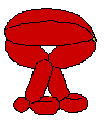 This completes the body, which so far looks
something like a walking football. Now we need to add the head and tail.
This completes the body, which so far looks
something like a walking football. Now we need to add the head and tail.
![]() Inflate a red 260 leaving about 5" uninflated
at the end, and leaving about a 3" long nozzle before tying the knot. Twist off a
3/4" bubble and a 2" bubble. Give the 3/4" a Pinch Twist and then Toe Twist it to make the upper and lower beak. Give the 2" a loop twist for the head. The long
uninflated nozzle forms the wattles that hang down from the beak. Trim off the rolled end
for a better appearance.
Inflate a red 260 leaving about 5" uninflated
at the end, and leaving about a 3" long nozzle before tying the knot. Twist off a
3/4" bubble and a 2" bubble. Give the 3/4" a Pinch Twist and then Toe Twist it to make the upper and lower beak. Give the 2" a loop twist for the head. The long
uninflated nozzle forms the wattles that hang down from the beak. Trim off the rolled end
for a better appearance.
 Twist a 3" neck and then fold it over about
1" from the bottom. Hold the fold and squeeze it for a few seconds to make a bend in
the neck. Twist off a 4" bubble behind the neck and squeeze it lengthwise inside the
body. The neck should stick out of one end and the rest of the balloon from the other.
Twist a 3" neck and then fold it over about
1" from the bottom. Hold the fold and squeeze it for a few seconds to make a bend in
the neck. Twist off a 4" bubble behind the neck and squeeze it lengthwise inside the
body. The neck should stick out of one end and the rest of the balloon from the other.
 Twist two 2" bubbles and lock twist them
together. Wrap the remainder of the balloon around these to make the tail. It may be
necessary to squeeze some of the air down into the uninflated part to reach all the way
around. Tie the nipple off at the base of the tail and arrange the tail to stand upright.
Twist two 2" bubbles and lock twist them
together. Wrap the remainder of the balloon around these to make the tail. It may be
necessary to squeeze some of the air down into the uninflated part to reach all the way
around. Tie the nipple off at the base of the tail and arrange the tail to stand upright.
 In the U.S., Thanksgiving Day brings to mind
images of roased turkey, parades and football. We take a day off from work, eat too much,
and plan the next day's holiday shopping. But Thanksgiving in America is much more than
that. Here's a few notes from the World Book Encyclopedia about Thanksgiving:
In the U.S., Thanksgiving Day brings to mind
images of roased turkey, parades and football. We take a day off from work, eat too much,
and plan the next day's holiday shopping. But Thanksgiving in America is much more than
that. Here's a few notes from the World Book Encyclopedia about Thanksgiving:
- The first American Thanksgiving day was a religious day and did not involve feasting. It occurred Dec 4, 1619 at Berkley Plantation (near Charles City, Va.) in accordance with the charter which specified that their day of arrival be observed yearly as a day of thanksgiving to God.
- The first New England Thanksgiving set the theme of feasting. In the early autumn of 1621 the surviving settlers (nearly half had died) of the Plymouth colony held a three-day festival to give thanks to God for the progress made.
- There were eight special days of thanks observed during the revolutionary war for victories and God's protection.
- President Abraham Lincoln proclaimed the last Thursday in November, 1863 as "a day of thanksgiving and praise to our beneficent Father."
- Thanksgiving day was proclaimed formally on the last Thursday of November by presidential decree each year until 1939. That year President F.D. Roosevelt set it one week earlier.
- In 1941 congress set the fourth Thursday in November as Thanksgiving Day and made it a federal holiday.
Poinsettia
 Inflate a red 260 all the way, then slowly
release the air to let the whole balloon get very soft. As soon as the nipple end begins
to shorten, stop releasing air and tie the nozzle to the end of the nipple. Find the exact
middle and hold the two parts parallel. Roll one of the bubbles to make a twist
between them, giving you a full-sized, soft double bubble.
Inflate a red 260 all the way, then slowly
release the air to let the whole balloon get very soft. As soon as the nipple end begins
to shorten, stop releasing air and tie the nozzle to the end of the nipple. Find the exact
middle and hold the two parts parallel. Roll one of the bubbles to make a twist
between them, giving you a full-sized, soft double bubble.
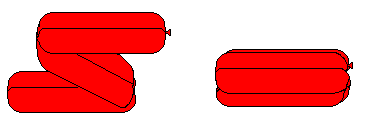 Divide the double bubble into three equal
parts and twist into three doubles. Fold the three sections together to produce what
resembles package of six fat hot dogs.
Divide the double bubble into three equal
parts and twist into three doubles. Fold the three sections together to produce what
resembles package of six fat hot dogs.
.
 Now push the two ends of the bundle together
and give the whole thing a twist. You are actually giving 6 bubbles a Loop Twist at the same time. Arrange the loops to form a neat 6-petal flower.
Now push the two ends of the bundle together
and give the whole thing a twist. You are actually giving 6 bubbles a Loop Twist at the same time. Arrange the loops to form a neat 6-petal flower.
 Inflate a yellow 260 about 4" and tie it
off. Twist 3 very soft 1" bubbles, then give each of them a Pinch Twist ,
followed by a Toe Twist. This forms the center of the flower.
Deflate the remaining bubble and cut off all but 2" of the remaining balloon.
Inflate a yellow 260 about 4" and tie it
off. Twist 3 very soft 1" bubbles, then give each of them a Pinch Twist ,
followed by a Toe Twist. This forms the center of the flower.
Deflate the remaining bubble and cut off all but 2" of the remaining balloon.
![]() Inflate a Green 260 leaving 3"
uninflated. Tie the nozzle to the deflated tail of the yellow balloon. Slip the knot
between the petals of the red flower leaving the yellow center on one side and the green
stem on the other.
Inflate a Green 260 leaving 3"
uninflated. Tie the nozzle to the deflated tail of the yellow balloon. Slip the knot
between the petals of the red flower leaving the yellow center on one side and the green
stem on the other.
 Twist a 1.5" bubble in the stem just below
the flower. Follow this with three large Loop Twist for leaves.
You may want to experiment with white and pink petals as well as red, since these are also
popular varieties of poinsettias.
Twist a 1.5" bubble in the stem just below
the flower. Follow this with three large Loop Twist for leaves.
You may want to experiment with white and pink petals as well as red, since these are also
popular varieties of poinsettias.
Cartoon Faces

The basic face begins with a 1-inch Pinch Twist followed by three 3-4 inch Loop Twist.

The pinch twist becomes the nose and the loop twists become the chin and cheeks.

Next, make two 3-4 inch bubbles and Lock Twist them together. this forms the upper half of the face. Eyes drawn on with a permanent marker will add a lot to the character of your figure. This basic face is only the foundation for more elaborate figures.
 Ears should be made between the two bubbles that
make the top of the face. For cat ears, make two small pinch twists after the first 3-inch
face bubble. After the ears, make the second 3-inch bubble and do the lock twist.
Ears should be made between the two bubbles that
make the top of the face. For cat ears, make two small pinch twists after the first 3-inch
face bubble. After the ears, make the second 3-inch bubble and do the lock twist. 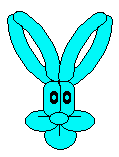
For a rabbit, the ears could be two pairs of 6-inch bubbles locked together.

You may want to modify the nose by adding a small Bird Body before creating the cheeks and chin. Of course, all these enhancements use up more of the balloon, and you may need to start with a second balloon at some point. If so, you can use a contrasting color to give even more character to your figure.
 In this example the eyes and cheeks are made from
a white balloon. The eyes need to be very soft to hold their position under the forehead.
In this example the eyes and cheeks are made from
a white balloon. The eyes need to be very soft to hold their position under the forehead.
For another example of a multi-balloon face, see the Tiger.
Tiger
本造型難度甚高,須使用 3 條 Orange 260q 及 1 條 White 260q,折法有 Lock Twist、Pinch Twist、Loop Twist 。將一條 orange 和 white 打氣後各留 5" 尾部未充氣 。
 先在頭部(打結處)轉一個 1.5''
泡泡。如圖,將打結後氣球之多餘尖端部分拉緊至關節處旋轉以形成一個熊耳朵Pinch Twist,這將是老虎的鼻尖。
先在頭部(打結處)轉一個 1.5''
泡泡。如圖,將打結後氣球之多餘尖端部分拉緊至關節處旋轉以形成一個熊耳朵Pinch Twist,這將是老虎的鼻尖。
 將白色氣球扭轉一個2吋泡泡與這鼻子結合(交叉後轉一圈),再轉一個等大的2吋白色泡泡,將此二個白色泡泡旋在一起後,共同接在一個柔軟的(捏出球內氣體再轉)
1.5" 橘色泡泡處。這樣就形成老虎的鼻子。
將白色氣球扭轉一個2吋泡泡與這鼻子結合(交叉後轉一圈),再轉一個等大的2吋白色泡泡,將此二個白色泡泡旋在一起後,共同接在一個柔軟的(捏出球內氣體再轉)
1.5" 橘色泡泡處。這樣就形成老虎的鼻子。
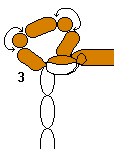 然後將橘色氣球分別轉出 2",
1.5", 3",2", 2"
共五個泡泡(所有的泡泡要往同一個方向各轉三圈以免鬆開),先將這些泡泡環成一圓圈而鎖住。再將二個1.5"的泡泡各做出一個熊耳朵來。
然後將橘色氣球分別轉出 2",
1.5", 3",2", 2"
共五個泡泡(所有的泡泡要往同一個方向各轉三圈以免鬆開),先將這些泡泡環成一圓圈而鎖住。再將二個1.5"的泡泡各做出一個熊耳朵來。
接著白色氣球轉出二個十分柔軟的2吋泡泡以 Lock Twist鎖好後塞入橘色氣球內以形成眼睛。
 做出一個1吋白泡泡與眼睛區隔開來(這種區隔的泡泡可避免一個關節處因結合太多泡泡而變的難以施工)。接著白色氣球轉出一個1"的熊耳朵當固定結,緊跟著轉出一個大的
6" 象耳朵Loop Twist當作下巴,這樣最難的頭部已完成。
做出一個1吋白泡泡與眼睛區隔開來(這種區隔的泡泡可避免一個關節處因結合太多泡泡而變的難以施工)。接著白色氣球轉出一個1"的熊耳朵當固定結,緊跟著轉出一個大的
6" 象耳朵Loop Twist當作下巴,這樣最難的頭部已完成。
 轉出一個1吋橘色泡泡做區隔,然後轉出一個1.5"橘色熊耳朵當固定結。而白色氣球也轉出一個1吋泡泡做區隔後,隨即將二條氣球的關節點扭轉在一起。
轉出一個1吋橘色泡泡做區隔,然後轉出一個1.5"橘色熊耳朵當固定結。而白色氣球也轉出一個1吋泡泡做區隔後,隨即將二條氣球的關節點扭轉在一起。
 抓著白色氣球未充氣的尾部環繞於頭後面之橘色熊耳朵上固定,並將等分為二平行泡泡。然後將橘色氣球塞入白色氣球的等分節點內,轉一圈後固定。這樣肚子就形成了,留下的一段橘色氣球就是虎的一條腿。
抓著白色氣球未充氣的尾部環繞於頭後面之橘色熊耳朵上固定,並將等分為二平行泡泡。然後將橘色氣球塞入白色氣球的等分節點內,轉一圈後固定。這樣肚子就形成了,留下的一段橘色氣球就是虎的一條腿。
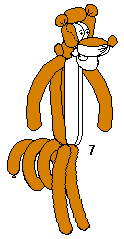 接著要折出一條橘色彎曲尾巴,可是一件頭痛的事。由於原創者 Professor Wonder
並沒有介紹的很詳細,小弟我幾經思量,自創一種方法稱為JBN旋尾法:先將氣球吹飽氣後完全洩氣(目的在於降低氣球的彈性),接著吹出另一條氣球綁好結後當工具,準備一點膠帶(使用貼紙箱那種黏性低的黃色膠帶),將洩氣後的橘色氣球尾部貼在工具氣球上(橘色氣球只要貼住1cm),然後將橘色氣球攤平繞在工具氣球上(像貼膠帶似的繞在同一圈)。最後由橘色氣球的頭部打氣(工具氣球須以雙腿夾緊而打氣時橘色氣球須貼近工具氣球),橘色氣球打滿時自動會將膠帶撐開,這樣就能打出一條漂亮的彎曲尾巴來了(偷偷告訴您這個好方法,不要告訴別人哦!)。
接著要折出一條橘色彎曲尾巴,可是一件頭痛的事。由於原創者 Professor Wonder
並沒有介紹的很詳細,小弟我幾經思量,自創一種方法稱為JBN旋尾法:先將氣球吹飽氣後完全洩氣(目的在於降低氣球的彈性),接著吹出另一條氣球綁好結後當工具,準備一點膠帶(使用貼紙箱那種黏性低的黃色膠帶),將洩氣後的橘色氣球尾部貼在工具氣球上(橘色氣球只要貼住1cm),然後將橘色氣球攤平繞在工具氣球上(像貼膠帶似的繞在同一圈)。最後由橘色氣球的頭部打氣(工具氣球須以雙腿夾緊而打氣時橘色氣球須貼近工具氣球),橘色氣球打滿時自動會將膠帶撐開,這樣就能打出一條漂亮的彎曲尾巴來了(偷偷告訴您這個好方法,不要告訴別人哦!)。
將此橘色氣球留一段與腿等常的長度後與另一條腿旋轉結合(腿要扳直),這樣就有雙腿及漂亮的彎曲尾巴了。最後再打一條橘色氣球塞入白色肚子與橘色背脊之間形成雙手(要彎成弧度較漂亮,或者發揮想像力彎出各種手勢)。OK,可愛的跳跳虎在此祝您新的一年運勢亨通好事成!
|
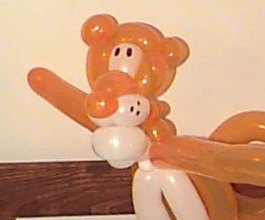
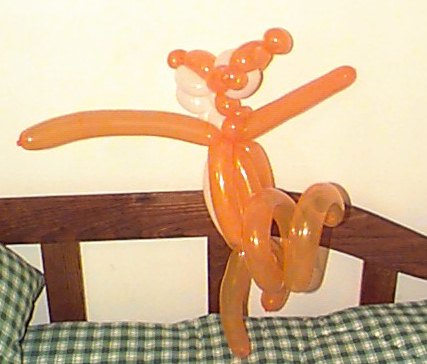

 Professor Wonder提供資料,著作權屬其所有,
Professor Wonder提供資料,著作權屬其所有,歡樂氣球網擁有中文之合法使用權, 非經同意不得拷貝、仿製或引用於任何平面與儲存媒體。
歡樂氣球網 ® Joy Balloon Net. Copyright 2017, All Rights Reserved.
本站是氣球教學網站,並不提供商業服務
